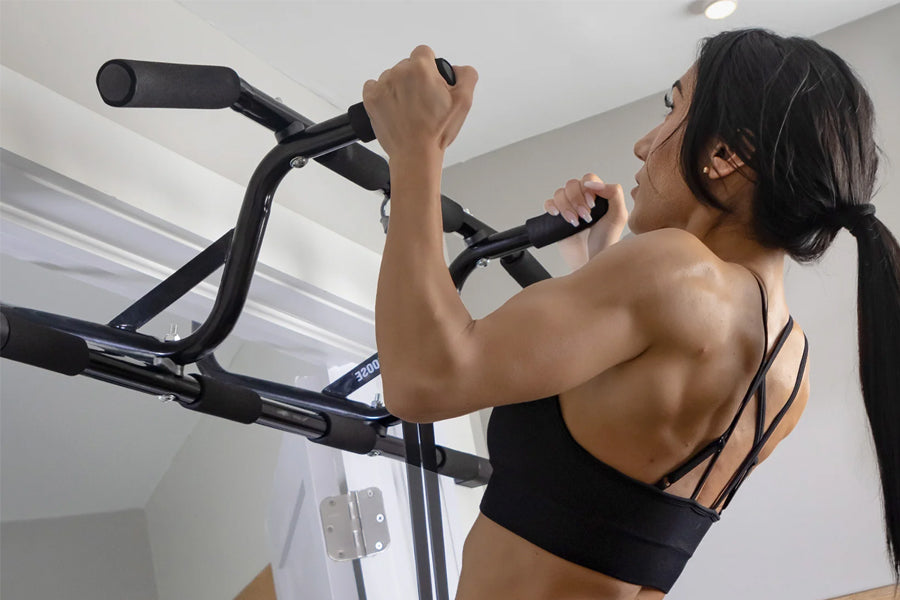The pull-up exercise is a great way to improve your upper body strength and tone your muscles. This exercise may be done with or without weights, making it an easy addition to any fitness plan. However, it takes a lot of self-confidence to effectively raise one's chin over a pull-up bar from a dead hang position.
The pull-up is a challenging exercise that takes a lot of upper-body strength and coordination to do correctly. It is important to practice this move like any other skill if you want to be able to do it correctly.
To master your first pull-up, you need to approach it like any other skill. You need to build a foundation by practicing regularly and having a plan in place to make sure you succeed.
To do a pull-up, start by gripping the bar with your hands shoulder-width apart. Bring your chin above the bar, hold that position for a few seconds, and lower yourself back down to the starting position. Repeat for desired reps. Here is how you do a complete pull-up video guide.
If you're new to pull-ups, start with bodyweight only and gradually work your way up to adding weights. For an extra challenge, try performing pull-ups with one arm at a time. Remember to keep good form throughout the exercise to avoid straining your hand muscles.
Related Article: 5 Reasons Why Wrist Training is Important for Bodybuilders
Can a Beginner Do Pull-Ups Everyday
Absolutely! In fact, pull-ups are a great exercise for beginners because they can be performed with little to no equipment and provide a full-body workout.
Of course, as with any exercise, it's important to listen to your body and not overdo it. If you're new to pull-ups, start slowly by doing a few reps per day and gradually increasing the number as you become stronger.
Most importantly, have fun and don't be scared to try different variations of pull-ups (e.g., wide grip, close grip, chin-ups) or mix things up. There are countless possibilities when it comes to this versatile exercise!
It can take a beginner several weeks to months to be able to do a pull-up. The key is to consistently train the muscles used in a pull-up, which are the latissimus dorsi (or lats), biceps, and brachioradialis. These muscles must be strong enough to lift your entire body weight.
Beginner athletes should focus on exercises that target these muscle groups, such as lat pull-downs, bicep curls, and rows. As you become stronger, you will be able to slowly add pull-ups into your routine.
Remember to start slow and increase the number of repetitions gradually. With consistency and dedication, you'll be able to achieve your pull-up goals in no time. Let us have a look at the muscles that a complete pull-up stimulates.
Related Article: How to Fix the Issue of Losing Your Grip During Lifting
Muscles Activated During a Pull-Up
There are many benefits to pull-ups, which is why they are such a popular exercise. Pull-ups work the large muscles in your back and your biceps and shoulders. This makes them an excellent compound exercise for building overall strength and muscle mass.
In addition to increasing strength, pull-ups also help improve your posture by strengthening the muscles that support your spine. They can also help you become strong by building up the muscles around your joints.
Pull-ups are a great way to build upper body strength, but they can also be used to tone your midsection. Doing pull-ups with a narrow grip will target your abs more than a wide grip exercise. Let us have a look at the muscles targeted when doing one complete pull-up.
A Pull-up may work these muscles by contracting them when you bring your chin up over the bar. This exercise can be performed with a wide grip, which will target the outer muscle group, or a narrow grip, which will target the inner muscles.
Latissimus Dorsi
The latissimus dorsi is a flat, large muscle that extends from the lower back to the upper arm. It is responsible for bringing the arm down and back and for rotation of the shoulder. The latissimus dorsi is often referred to as the "lats.”
Pectoralis Major
The pectoralis major is a large muscle that covers the chest. It is responsible for bringing the arms across the body and for the rotation of the shoulder.
Biceps Brachii
The biceps brachii is a double-headed muscle that runs from the shoulder to the elbow. It is responsible for bending the elbow and supinating the forearm (turning the palm up).
Brachialis
The brachialis muscle runs from the elbow to the shoulder. It is responsible for bending the elbow.
5. Teres Major
The Teres major runs from the shoulder to the elbow. It is responsible for bringing the arm down and back, as well as for rotation of the shoulder.
Triceps Brachii
The triceps brachii is a triple-headed muscle that runs from the elbow to the shoulder. It is responsible for extending the elbow.
Rhomboid Major
The rhomboid major is a muscle that runs from the spine to the shoulder. It is responsible for bringing the shoulder blade down and back.
Levator Scapulae Blade Up And Down.
The levator scapulae muscle runs from the neck to the shoulder. It is responsible for bringing the shoulder blade up and down.
Erector Spinae
The erector spinae is a large muscle that runs along the spine. It is responsible for keeping the spine upright and for extending the back.
Flexor, or Grip.
The flexor muscles of the hand and forearm are responsible for bending the wrist and fingers.
4 Weeks Six-Day Pull-Up Workout Plan for Beginners
If you're looking for a workout plan that will help you get stronger and improve your pull-ups, this six-day plan is perfect for beginners. This workout incorporates different exercises to target your back, biceps, and shoulders, all of which will help improve your pull-up performance. The best part is that you can complete this workout in just 30 minutes per day.
Related Article: The Ultimate Guide to Choose the Best Pull-Up Bar for Your Door Safety
Day 1: Assisted Pull-Up

The first exercise in this workout is the assisted pull-up. This exercise is great for beginners because it helps you build up the strength needed to perform a traditional pull-up.
To do this exercise, you will need a resistance band and a pull-up bar. Start by attaching the resistance band to the pull-up bar and then wrapping it around your legs.
Next, grasp the pull-up bar with an overhand grip and begin to pull yourself up until your chin is over the bar. Lower yourself back down to the initial position and repeat.
You may use DMoose Pull Up Resistance and Workout Bands to perform this workout. The best part is that you can use different levels of resistance and your own body weight to put different amounts of tension on your muscles. This is because they work your muscles from your shoulders to your back and tone your body at the gym, giving you results that last.
|
Week 1 |
Sets 3 |
Reps 2 |
|
Week 2 |
Sets 3 |
Reps 2 |
|
Week 3 |
Sets 3 |
Reps 2 |
|
Week 4 |
Sets 3 |
Reps 2 |
Day 2: Negative Pull-Up

In this modified pull-up, you do not have to do any pulling and just have to master the descent. To begin, raise your chin over the bar and jump up. Slowly but steadily, bring yourself down to the ground.
|
Week 1 |
Sets 3 |
Reps 6 |
|
Week 2 |
Sets 3 |
Reps 6 |
|
Week 3 |
Sets 3 |
Reps 6 |
|
Week 4 |
Sets 3 |
Reps 6 |
Day 3: Shoulder Pull-Up

Pull yourself up using the bar. Pull yourself up a little bit with your shoulders, then descend back down to the starting position.
|
Week 1 |
Sets 3 |
Reps 12 |
|
Week 2 |
Sets 3 |
Reps 14 |
|
Week 3 |
Sets 3 |
Reps 12 |
|
Week 4 |
Sets 3 |
Reps 14 |
Day 4: Negative Pull-Up
|
Week 1 |
Sets 3 |
Reps 12 |
|
Week 2 |
Sets 3 |
Reps 14 |
|
Week 3 |
Sets 3 |
Reps 12 |
|
Week 4 |
Sets 3 |
Reps 14 |
Day 5: Assisted Pull-Up

On this day, use a medium resistance band to help you out more than you did the first day.
|
Week 1 |
Sets 3 |
Reps 4 |
|
Week 2 |
Sets 3 |
Reps 5 |
|
Week 3 |
Sets 3 |
Reps 4 |
|
Week 4 |
Sets 3 |
Reps 5 |
Day 6: Inverted Row

Lie down on the ground and grasp the bar (or table) using an overhand grip after finding the right one. Pull yourself up until your chest comes close to the bar, then carefully lower yourself down to the starting position. Because the inverted row is more difficult the further your feet are from the bar, you may alter your foot placement accordingly.
|
Week 1 |
Sets 3 |
Reps 10 |
|
Week 2 |
Sets 3 |
Reps 12 |
|
Week 3 |
Sets 3 |
Reps 10 |
|
Week 4 |
Sets 3 |
Reps 12 |
This workout plan is very simple and possible in a nearby park or at your home. All you need to do is get yourself a pull up bar doorways by DMoose. It is easily portable, with multi-grip handles, and can be used in your regular routine. It works best in doorways, against walls, or any other sturdy fixtures. So get that toned body you always wanted; it's now a walk in the park.
Wrapping Up
As a beginner, aim to do 3-5 pull-ups per day. This will help you increase your muscle strength and endurance so that you can eventually do more pull-ups. The benefits of doing pull-ups are vast and include improving posture, increasing muscle mass, strengthening the back and core muscles, and maximizing fat loss. If you want to see results quickly, try our 6-day workout plan for 4 weeks that will have you doing up to 50 pull-ups in just 6 days!
Reading List
Article Sources
- Kim, DeokJu, et al. "Effect of an Exercise Program for Posture Correction on Musculoskeletal." Journal of Physical Therapy Science, vol. 27, no. 6, June 2015, pp. 1791–94. PubMed Central, https://doi.org/10.1589/jpts.27.1791.











